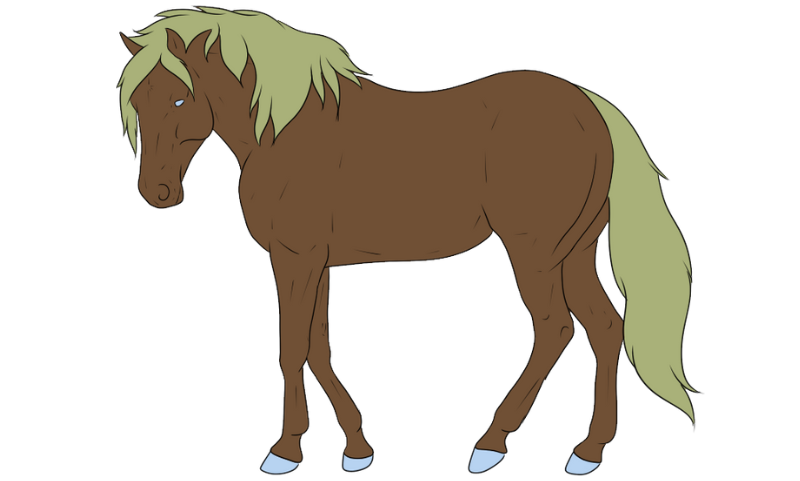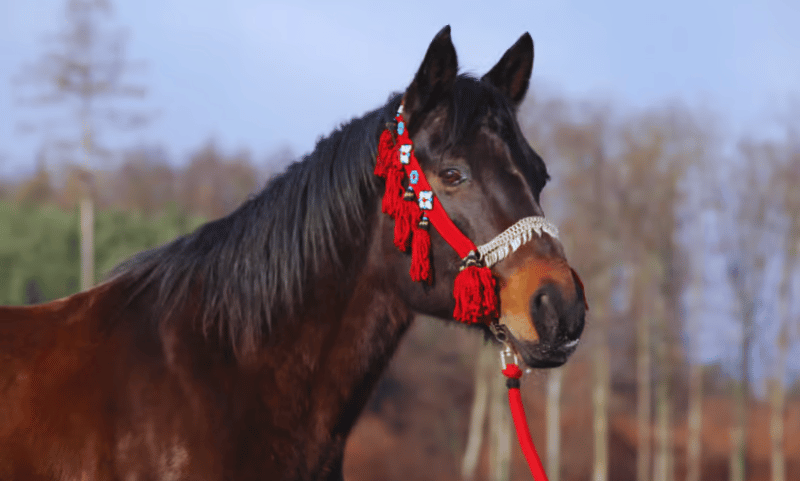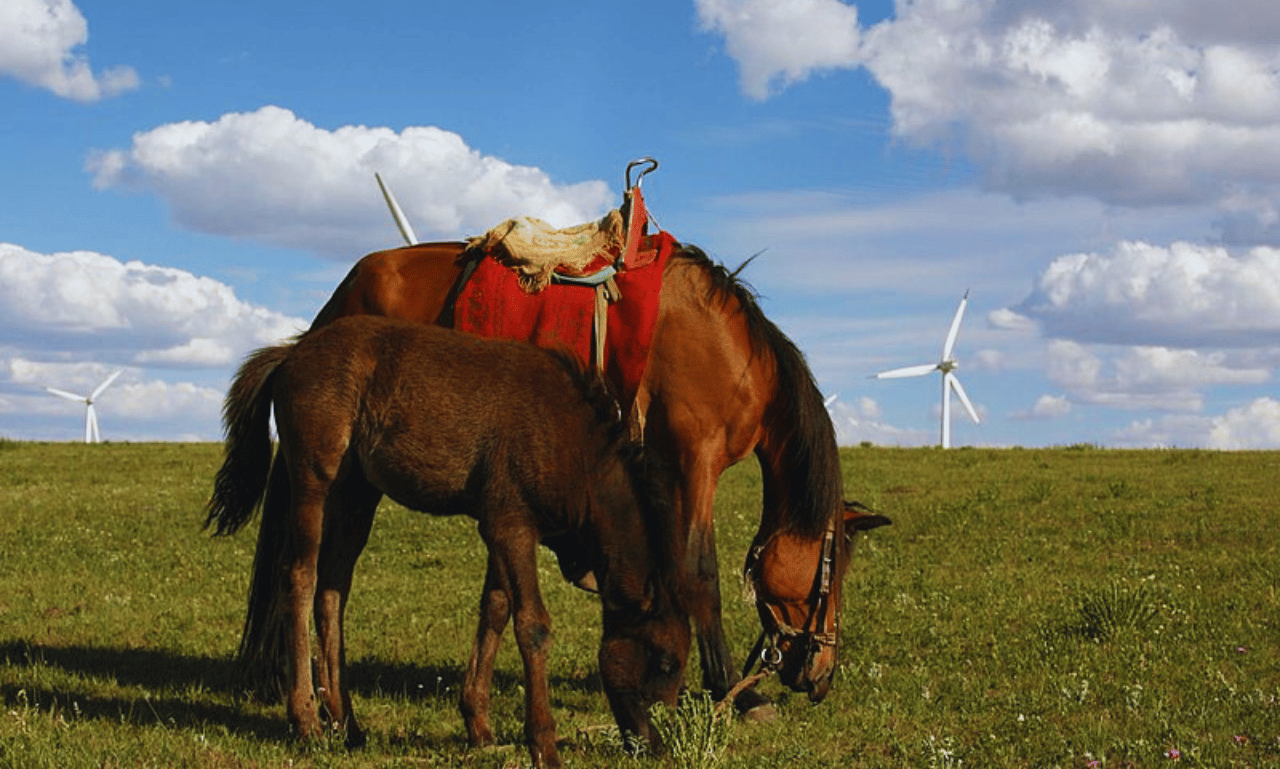The Abaga horse, a rare and remarkable breed originating from Inner Mongolia, China, stands out for its resilience, speed, and adaptability to harsh environments. Known for its predominantly black coat and robust build, this breed is a subtype of the Chinese Mongolian horse and has been selectively bred for racing and endurance. The Abaga is not only a symbol of cultural heritage but also a testament to the ingenuity of breeders who have optimized its traits for performance in extreme climates.
With fewer than 4,000 individuals recorded as of 2008, the Abaga horse is considered rare, making conservation efforts crucial to preserving this unique lineage. Its primary uses include racing, saddle riding, and milk production from mares. The Abaga’s ability to thrive in hypoxic high-altitude conditions and withstand freezing temperatures underscores its exceptional hardiness. This breed is particularly valued in equestrian sports and cultural events like the Naadam festival, where its speed and stamina shine.
Breed Quick Facts Table
| Characteristic | Details |
|---|---|
| Height Range | 13.4–13.8 hands (136–140 cm) |
| Weight Range | Approx. 300–350 kg (660–770 lbs) |
| Color Variations | Predominantly black; occasionally dark bay |
| Common Markings | Minimal; solid coat colors preferred |
| Temperament | Hardy, docile, intelligent |
| Primary Uses | Racing, saddle horse, mare milk production |
| Life Expectancy | 20–25 years |
| Origin | Inner Mongolia, China |
| Conservation Status | Rare (<4,000 individuals as of 2008) |
Breed History & Development

The Abaga horse traces its roots to the steppes of Inner Mongolia, where it evolved as a subtype of the Chinese Mongolian horse. These horses have been bred for centuries by nomadic herders who prioritized stamina, speed, and adaptability to extreme conditions. The name “Abaga” comes from the Abag Banner region in Xilingol League, which remains the breed’s primary breeding area.
While Mongolian horses are among the oldest domesticated breeds in the world—dating back to around 2000 BC—the Abaga was only officially characterized as a distinct type in 2009. Its development was influenced by both natural selection and selective breeding aimed at enhancing traits like endurance and speed for racing events such as those held during the Naadam festival.
Historically, Mongolian horses were integral to nomadic life as transportation animals and sources of milk and meat. However, the Abaga stands out due to its superior size and speed compared to other Mongolian horse types like the Wushen or Ujumqin. This distinction is attributed to targeted breeding programs that emphasize cardiovascular strength and muscular development.
Despite its ancient lineage, little genetic research has been conducted on the Abaga compared to more globally recognized breeds like Thoroughbreds or Arabians. However, studies have highlighted its potential for improving other Mongolian strains’ racing performance through crossbreeding.
Physical Characteristics Table
| Feature | Description |
|---|---|
| Head | Straight or slightly convex profile; broad forehead; large expressive eyes; small ears |
| Neck | Moderately long with good musculature |
| Body | Compact frame with a broad chest; muscular shoulders; long back; short sloping rump |
| Legs | Strong with well-defined joints; small but durable hooves |
| Hooves | Hard and resilient; adapted to rocky terrains |
| Movement | Smooth gaits with notable speed over short distances |
| Special Features | Thick coat for cold resistance; stamina adapted to hypoxic high-altitude environments |
The Abaga horse’s physical build reflects its steppe origins, where survival depends on strength and efficiency rather than aesthetic refinement. Its compact yet muscular frame allows it to excel in endurance activities while maintaining agility.
Temperament & Personality
The Abaga horse is celebrated for its calm, intelligent, and adaptable temperament, making it a versatile breed suitable for both novice and experienced riders. Its personality is shaped by centuries of selective breeding in the harsh environments of Inner Mongolia, where survival required resilience and a cooperative nature.
General Disposition
Abaga horses are known for their balanced temperament, which combines a docile nature with a willingness to work. They are neither overly spirited nor lethargic, striking a harmonious middle ground that makes them reliable companions. Their calm demeanor allows them to adapt easily to different handlers and environments, whether it’s rugged steppe terrain or structured equestrian facilities.
Trainability and Intelligence
These horses exhibit high intelligence and a natural curiosity, traits that make them quick learners. They respond well to training and are particularly adept at forming strong bonds with their handlers. This bond fosters trust and facilitates effective communication, which is essential for success in equestrian disciplines such as racing or trail riding.
Interaction with Humans and Other Animals
Abaga horses are highly sociable and thrive in environments where they can interact with humans and herd mates. Their gentle disposition makes them ideal for families, including those with children. They are patient with young or inexperienced riders, often adapting their behavior to ensure safety and comfort. Additionally, their gregarious nature enables them to integrate seamlessly into herds, enhancing group cohesion and security.
Suitable Handlers
Thanks to their calm and adaptable nature, Abaga horses are suitable for a wide range of handlers:
- Novice Riders: Their patience and forgiving temperament make them excellent choices for beginners learning the basics of horseback riding.
- Experienced Equestrians: Their intelligence and agility allow skilled riders to train them for specialized activities such as racing or competitive trail riding.
Common Behavioral Traits
Abaga horses exhibit several behavioral traits that set them apart:
- Hardy and Resilient: Adapted to extreme climates, they can endure hypoxic high-altitude conditions and freezing temperatures without compromising performance.
- Gentle and Trusting: Their friendly demeanor fosters strong bonds with humans, making them ideal for therapeutic settings or family activities.
- Curious and Observant: These traits enhance their ability to learn new tasks quickly while maintaining focus during training sessions.
Performance & Uses
The Abaga horse excels in various disciplines, thanks to its unique combination of speed, endurance, and adaptability. While it is primarily bred for racing, its versatility allows it to perform well in other equestrian activities, making it a valuable breed for both traditional and modern uses.
| Discipline | Suitability Rating | Notes |
|---|---|---|
| Racing | ★★★★★ | Bred specifically for speed; excels in short- to medium-distance races. |
| Trail Riding | ★★★★☆ | Hardy and sure-footed; ideal for navigating rugged terrains. |
| Endurance | ★★★★☆ | Adapted to long distances in extreme climates; stamina is a key strength. |
| Driving | ★★★☆☆ | Can be trained for light driving tasks but not a primary use. |
| Therapeutic Riding | ★★★★☆ | Gentle and calm demeanor makes it suitable for therapy programs. |
| Cultural Events | ★★★★★ | Integral to traditional Mongolian festivals like Naadam. |
Racing
The Abaga horse is most renowned for its racing abilities, particularly in traditional Mongolian events such as the Naadam festival. These races often cover long distances over uneven terrain, showcasing the breed’s speed and stamina. Abaga horses are also gaining recognition in modern equestrian racing circuits within China.
Trail Riding
With their strong legs, compact frame, and natural agility, Abaga horses are well-suited for trail riding. They can effortlessly traverse rocky paths, steep inclines, and other challenging terrains. Their calm temperament ensures they remain steady even in unpredictable environments.
Endurance
The breed’s ability to thrive in hypoxic high-altitude conditions makes it an excellent choice for endurance riding. Abaga horses can cover long distances without tiring quickly, a trait that has been honed through centuries of use by nomadic herders who relied on them for transportation across vast steppes.
Cultural Significance
The Abaga horse plays a vital role in Mongolian culture, particularly during festivals like Naadam, where it competes in traditional horse races that are central to the event. These races are not only a test of speed but also a celebration of the breed’s historical importance and connection to Mongolian heritage.
Health & Management

Abaga horses are known for their hardiness and ability to thrive in harsh environments with minimal care. However, like all breeds, they require proper management to maintain optimal health and performance.
Common Health Concerns
While generally robust, the Abaga horse may face some health challenges:
- Hoof Health: Due to their small but durable hooves, regular trimming and maintenance are essential to prevent issues like cracks or infections.
- Respiratory Conditions: Although adapted to high altitudes, prolonged exposure to dust or poor ventilation can lead to respiratory problems.
- Parasites: As with many grazing animals, they are susceptible to internal parasites if deworming schedules are not maintained.
Special Care Requirements
Given their origins in cold climates, Abaga horses develop thick winter coats that protect them from freezing temperatures. However, if kept in warmer regions or during seasonal transitions, they may require careful grooming to manage shedding and prevent overheating.
Feeding Considerations
Abaga horses have efficient metabolisms and can thrive on sparse forage typical of steppe environments. Their diet should include:
- High-quality hay or pasture grass as the primary source of nutrition.
- Supplemental grains or concentrates if used for high-performance activities like racing.
- Access to mineral blocks to ensure balanced nutrition.
Exercise Needs
Regular exercise is crucial for maintaining the breed’s physical fitness and mental well-being:
- For working or performance horses: Daily exercise routines that include trotting or galloping.
- For leisure horses: Moderate activity such as trail rides or pasture turnout suffices.
Housing Requirements
Abaga horses are accustomed to open spaces and do best when provided with ample room to roam. While they can adapt to stables, access to outdoor paddocks is essential for their physical and psychological health.
Grooming Needs
Their thick coats require regular grooming, especially during seasonal changes when they shed heavily. Routine grooming not only keeps their coat healthy but also helps build trust between the horse and handler.
Breed Demographics
The Abaga horse is a rare breed, with its population concentrated primarily in Inner Mongolia, China. While its numbers are limited, the breed holds cultural and economic significance in the region, leading to ongoing conservation efforts.
| Region | Population | Trend |
|---|---|---|
| Inner Mongolia (China) | ~4,000 (as of 2008) | ↓ Declining due to modernization and reduced reliance on horses. |
| North America | Minimal | → Stable; limited interest outside of China. |
| Europe | Minimal | → Stable; primarily seen in cultural exhibitions. |
| Other Regions | Negligible | → Stable; no significant breeding programs outside China. |
Population Trends
The Abaga horse population has been steadily declining over the years due to reduced reliance on horses for transportation and agriculture in modern society. Mechanization and urbanization have contributed to this trend, as has the shift in focus toward more globally recognized breeds for equestrian sports.
Conservation Efforts
To combat the decline, local governments and breeders in Inner Mongolia have initiated conservation programs aimed at preserving the breed’s genetic integrity. These efforts include:
- Establishing breeding farms dedicated to maintaining pure Abaga bloodlines.
- Promoting the breed through cultural events like the Naadam festival.
- Encouraging research into the breed’s genetic traits to highlight its unique characteristics.
Modern Role & Future
The Abaga horse continues to play a vital role in both traditional and modern contexts. While its primary use remains rooted in cultural practices, its potential for equestrian sports and tourism is gradually being explored.
Current Breeding Programs
Breeding programs in Inner Mongolia focus on enhancing the breed’s racing abilities while preserving its hardiness and adaptability. Selective breeding aims to improve speed and stamina without compromising the traits that make the Abaga horse well-suited to harsh environments.
Modern Uses
- Cultural Events: The breed remains central to Mongolian festivals like Naadam, where it competes in traditional races.
- Equestrian Sports: Though less common, Abaga horses are beginning to appear in endurance riding competitions due to their natural stamina.
- Tourism: The breed’s association with Mongolian heritage makes it a popular choice for cultural tourism experiences, including horseback treks across the steppes.
Future Outlook
The future of the Abaga horse depends on continued conservation efforts and increased awareness of its unique qualities. With proper support from local governments and international equestrian communities, the breed could see a resurgence in popularity, particularly as interest grows in preserving rare and culturally significant horse breeds.
Buying & Ownership Guide
Purchasing and owning an Abaga horse is a rewarding experience, but it requires careful planning and consideration. From selecting the right horse to managing ongoing care, understanding the costs and responsibilities involved is essential for a successful ownership journey.
Average Price Ranges
The Abaga horse, being a rare and regionally specific breed, is not as widely available as more common breeds like Thoroughbreds or Arabians. Prices can vary depending on the horse’s age, training, and pedigree:
- Untrained or Young Horses: $3,000–$5,000
- Trained Horses (Racing or Riding): $6,000–$10,000
- Exceptional Bloodlines or Proven Performers: $10,000+
Due to its rarity, finding an Abaga horse outside of Inner Mongolia may involve additional costs for transportation or importing.
Where to Find Breeders
The majority of Abaga horses are bred in Inner Mongolia, particularly in the Abag Banner region. If you’re interested in purchasing this breed:
- Local Breeders: Contact breeders in Inner Mongolia who specialize in Abaga horses. They are often involved in cultural events like the Naadam festival and may have connections to reputable sellers.
- Equestrian Networks: Reach out to equestrian communities or Mongolian horse associations for guidance on locating breeders.
- Online Listings: Specialized equine marketplaces may occasionally list Abaga horses for sale, though availability is limited.
What to Look for When Buying
When selecting an Abaga horse, consider the following factors:
Health and Soundness:
- Arrange a pre-purchase veterinary examination (PPE) to assess the horse’s overall health.
- Check for any signs of lameness or respiratory issues.
Temperament:
- Observe the horse’s behavior during handling and riding.
- Ensure its temperament aligns with your experience level and intended use.
Conformation:
- Evaluate the horse’s physical build for balance and symmetry.
- Look for strong legs, a broad chest, and a compact frame—traits typical of the breed.
Training Level:
- Determine whether the horse has been trained for your intended discipline (e.g., racing, trail riding).
- Ask about its previous performance history if applicable.
Registration Requirements
While the Abaga horse is not widely recognized by international registries like the FEI (Fédération Equestre Internationale), local Mongolian or Chinese equine organizations may offer registration services. Ensure that:
- The horse’s lineage is documented.
- Any necessary paperwork for transportation or ownership transfer is completed.
Breed Associations and Resources
To learn more about Abaga horses or connect with breeders and enthusiasts, consider reaching out to:
- Local Mongolian Horse Associations
- Equestrian groups specializing in Asian breeds
- Cultural organizations promoting traditional Mongolian practices
Care Costs Table
Owning an Abaga horse involves ongoing expenses that vary based on location, care standards, and usage. Below is an estimate of monthly and annual costs:
| Expense Category | Monthly Estimate | Annual Estimate |
|---|---|---|
| Feed | $150–$300 | $1,800–$3,600 |
| Healthcare | $50–$100 | $600–$1,200 |
| Hoof Care | $45–$150 | $540–$1,800 |
| Boarding | $200–$1,500 | $2,400–$18,000 |
| Training | $200–$800 | $2,400–$9,600 |
| Equipment (Tack) | $50–$200 | $600–$2,400 |
Note: Costs may vary significantly depending on whether you board your horse at home or at a professional facility.
Additional Costs to Consider
- Transportation: Importing an Abaga horse from Inner Mongolia may cost thousands of dollars depending on distance and logistics.
- Insurance: Equine insurance can range from $200 to over $2,000 annually based on coverage.
- Emergency Fund: Set aside at least $1,000 annually for unexpected veterinary expenses.
Resources & References
For further information about the Abaga horse, consider exploring these resources:
- Mongolian Horse Associations: Organizations dedicated to promoting and preserving Mongolian horse breeds.
- Cultural Events: Festivals like Naadam offer firsthand experiences of the breed in action.
- Equine Research Papers: Studies on Mongolian horses provide insights into their genetics and adaptability.
- Local Breeders: Contact breeders in Inner Mongolia for detailed guidance on purchasing and caring for an Abaga horse.
- Historical Sources: Books and articles on nomadic Mongolian life often highlight the role of horses like the Abaga in traditional practices.
Conclusion
The Abaga horse is a remarkable breed that embodies the resilience and cultural heritage of Inner Mongolia. With its compact yet powerful build, calm temperament, and exceptional stamina, this horse has proven itself in both traditional and modern roles. Whether racing across the steppes during the Naadam festival or navigating rugged trails, the Abaga horse is a testament to centuries of selective breeding aimed at creating a versatile and hardy equine companion.
Despite its many strengths, the Abaga horse faces challenges due to its rarity and declining population. Conservation efforts are critical to preserving this breed for future generations, not only as a symbol of Mongolian culture but also as a valuable contributor to equestrian sports and tourism. For those fortunate enough to own an Abaga horse, the experience is deeply rewarding, offering a unique connection to one of the world’s most resilient and historically significant horse breeds.
As interest in preserving rare breeds grows globally, the Abaga horse has the potential to gain recognition beyond its native region. Its adaptability, intelligence, and versatility make it an excellent choice for riders seeking a reliable partner for both performance and leisure.
Citations:
[1] https://preeders.com/en/animals/breeds/horses/abaga.htm
[2] https://en.wikipedia.org/wiki/Abaga_horse
[3] https://sites.google.com/kavalrigames.com/etghelpcenter/horses/personality
[4] https://en.wikipedia.org/wiki/Abaga_horse
[5] https://preeders.com/en/animals/breeds/horses/abaga.htm
[6] https://4theloveof-horses.com/historical-guide-to-horse-breeds/
[7] http://www.als-journal.com/1113-24/
[8] https://en.wikipedia.org/wiki/Chinese_Mongolian_horse

